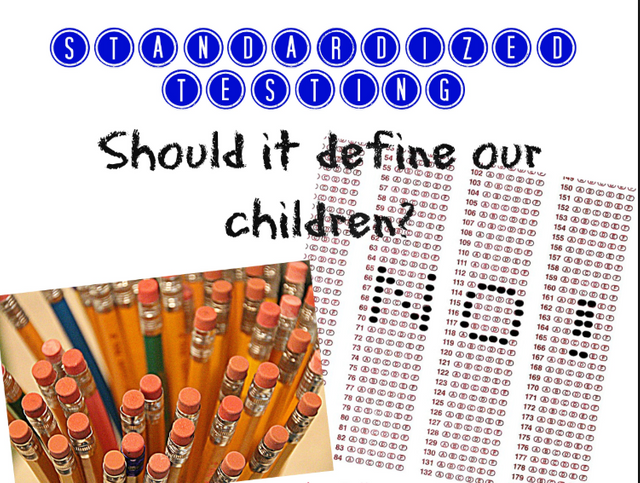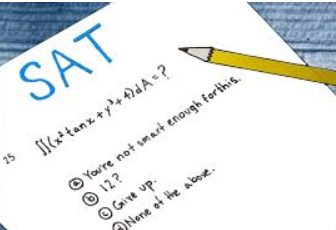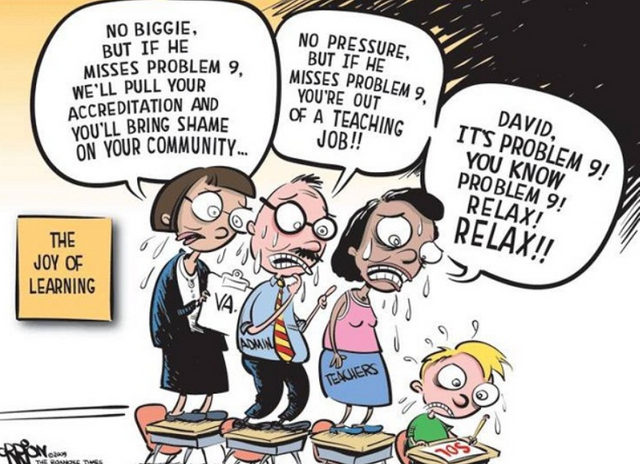A Call for reevaluation of standardized testing protocol
Abstract
The first case of standardized testing came in 1914 with the Kansas Talent Reading test as the first multiple-choice standardized test created by Kansas school director Frederick J Kelly. Since its inception in 1926, the Scholastics Aptitude Test (SAT) has been the common standardized test which became the standard after World War II as the official entrance exam for aspiring college students. The modern iteration of national standardized testing in schools was enacted into law by Lyndon B. Johnson in 1965 with the Elementary and Secondary Education Act. This reactionary move on the part of the Johnson administration was caused by the rise of the Soviet Union space program which education experts said highlighted the failing education system in the United States. Primarily the purpose of standardized testing is to assess student’s propensity for achievement, which promotes the recognition of students who are highly skilled and talented. Standardized testing is viewed as a measure to raise the standards of education to be more equitable and only to be enforced with nationally standardized testing parameters. Also, standardized tests identify students who are in need of a remedial curriculum that is suitable and tailored to their needs for a particular core subject or to improve a skill set.
The Need for Accountability
Nationwide achievement standards are in place by the federal government for monitoring teacher accountability and to measure student academic performance. However, parameters for curriculum are in the hands of the states with assistance from the Department of Education to implement changes to academic assessment protocol when permitted. Federal oversite is due to the No Child left behind act. The Democrat and Republican parties authored this bill with President Bush passing it in 2002, which stated all schools that receive federal funds must adhere to standardized testing regulations. For any standardized test to be worth any merit, it must be a proper barometer for gauging what students learned from the curriculum presented by teachers. (Baker, 2010, p. 6). The assumption on standardized testing says students scores depict their level of competence and understanding of the curriculum. Today standardized testing is a critical component for measuring accountability of teachers, and to assess if they are adequately introducing the curriculum to students. Teachers and administrators use the data presented by standardized tests to fill gaps in the curriculum or to improve it by meeting the ever-growing needs of students from various backgrounds (Mendoza-Denton, 2014, p. 475). Data is also used to distribute state funding to different school districts appropriately, and to accurately place students in schools and classes with the best teachers that will meet their needs. Advocates of standardized testing say it improves students test-taking skills and ensures students competence at core academic skills. However, critics would say standardized testing is old and out of date. As we evolve into an innovation-based economy, if we only focus primarily on reading comprehension and math skills for SAT prep to “the detriment of other knowledge,” instead educators must foster students creative, analytical wisdom-based skills that apply to the global economic environment we currently live (Baker, 2010, p. 6). Parents and critics believe standardized testing is a waste of time because of the one-size-fits-all model for curriculum given by the states do not fully divulge a student’s academic achievement.
Problem Statement
With the growing concern over the legitimacy of standardized testing nationwide, many speculate the sole purpose of this test is to cover a narrow core curriculum only to prepare students for taking the test itself. This handcuffs teachers into providing students in a small set of subjects and skills, instead of exploring the full extent and depth of the curriculum as needed. Much of the research thus far has yet answered questions such as; How effective has Standardized testing and the curriculum associated with it prepared students for college? Is federal government involvement in standardized testing, and classroom curriculum restricting teacher’s ability to be effective educators? Did all existing studies report positive outcomes from teacher accountability assessment, or has standardized testing created adverse effects for teachers on a professional level? In this research proposal, we question the validity of standardized testing as a useful barometer for assessing student achievement in core subjects, while determining if the curriculum is meeting the needs of students academically within the parameters set by the federal government.
Justification in the Literature
Research has shown that standardized testing falls short of assessing student’s aptitude and achievement. Critics say that administering a test in a one-size-fits-all manner to students nationwide regardless of disability, low socioeconomic status or mobility to a variety of schools with diverse curriculum makes it insufficient to gauge assessment. The increased pressure from high-stakes testing on school faculty, and administrators along with the students have created a state of panic for everyone involved. The result has left students becoming misrepresented falling below state requirements of achievement with many disadvantaged children needs not being met by statewide curriculum (Dotson, 2010, p. 33).
Furthermore, standardized tests that are administered in the spring look back on past test scores of students from previous grade levels to give educators in the counted background of the student’s competence with the use of a “value-added” approach (Allen, 2013, P. 4). This protocol of standardized testing does not equate the landscape of the classroom and the curriculum administered within, but only measures students’ academic prowess. Standardized tests focus on mathematics and reading comprehension. They are given twice a year in 3rd to 8th grade, and in high school students take the SAT along with state graduation tests. These tests lack any implementation of value-added methods such as history, science, art, and music which add culture character and problem-solving skills which are intrinsic in a global economy (Baker, 2010, p. 8). The restriction of a broad-based curriculum for a focus on a narrower set of tests-based skills hampers students from acquiring the real-world skills needed to compete globally. The curriculum provided on the SAT does not prepare some high school graduates who performed well on standardized tests but fell short to meet first-year college student requirements in reading and arithmetic forcing them to take remedial courses (Baker, 2010, p. 7). By law, federal mandates require teachers to be evaluated based on student standardized test scores which undermine teacher’s obligation to provide quality curriculum because teachers now have limited autonomy and only teach based on the test only to protect their jobs (Baker, 2010, p 7). This high level of professional scrutiny and regulation hampers the education industry’s ability to recruit new up-and-coming teachers and unfairly stigmatizes current teachers which causes them to lose their jobs or leave the profession outright diminishing the pool of quality teachers further (Baker, 2010, p. 6).
Impact on Students
The data from past research suggest that students are receiving too many hours of standardized testing which takes away from classroom instruction time. This form of testing has an adverse effect on S ability to reach proficiency levels in common core subjects, their ability to meet graduation requirements, and it also has a dramatic impact on their he psychological and emotional behavior in the classroom. There has been a consensus among parents and teachers that there needs to be an overhaul of assessment in the education system. Far too long we have parents and teachers who have argued there is less implication to meaningful pedagogy and persistence of monitoring isolated lower-level skills in standardized testing. Rather we should move to a system that assesses performance and learning through multiple holistic real-world concepts that coincide with a recompositing of the common core curriculum (Huddleston, 2015, p. 46).
Moreover, the anxiety brought on by standardized test upon students which makes them underperform on test is not because they don’t know the answers, it’s because they have a hard time conveying what they know and what they have learned within the construct of the test. Regarding the test, preparation statistics are drastically different among various racial and ethnic groups. In the name of accountability, standardized testing has created a setting for K-12 students to receive a lackluster curriculum centered around increasing test scores which puts pressure on teachers as well as students having outright resentment towards test taking (Li, 2018, p.4).
The analyzation process of standardized test scores for ELL students is also skewed. For instance, ELL historically has performed low on the standardized test compared to their native speaking counterpart, in turn, this drastically affects the overall scoring within school districts with onus falling upon the student body in the teachers. Most ELL students do not attend the same public schools as students who speak English as a first language. This is consistent with national statistics that say 70% of ELL students attend only 5000 elementary schools, in contrast only 13% of all students in America attended these same 5000 schools (Fry, 2008, p. 6). On average the schools that ELL students attend score far lower than test takers from other racial groups. More research suggests that the average proficiency of white test takers is dramatically lower in schools that had minimum ELL test takers to report schools rank in ELL proficiency. Research gathered from Arizona schools also suggest that African-American students proficiency rate scored lower when they were educated in schools that have a high student population in ELL students (Fry, 2008, p. 9). As America continues to receive an influx of immigrants from various nations around the world, there must be a reevaluation of standardized testing as an assessment tool for ELL. If the students struggle and achievement performance as they grasp English as a second language, how will they understand syntactic analysis and reading comprehension on standardized tests? More examples of standardized testings lackluster ability to accurately assess students. Data for minority students in Arizona suggest their performance on standardized tests is underpredicted by 1/5 the standard deviation in Arizona (Mendoza-Denton, 2014, p. 475). Many opponents of standardized testing argue how can ELL students be tested have teachers be held accountable for the results when ELL students are still learning the language, this leads to a misleading analysis of districts who are deemed as underperforming (Solórzano, 2008, P. 262). By proxy these tests are made for native English speakers, for the test to maintain any technical quality the culturally learned experience must be the same for all students, for ELL it is difficult because to master proficiency when they’re not native speakers, it becomes difficult for minority students in a dominant white-centric culture (Solórzano, 2008, P. 283).
There has been a subtle, yet apparent racial overtones associated with standardized testing since the inception of IQ tests in Europe. The first IQ come in conjunction with the study of eugenics which was seen as pseudoscience over time. The first IQ test was issued by French psychologist Alfred Binet where he used procedures such as measuring the head which was done by eugenicists, but then he later altered his procedure techniques and instead went with a questionnaire for his subjects (Au, 2015, p. 5). Overall standardized testing has been detrimental to minorities because it aligns with ideological meritocracy that helps strengthen and reaffirm white supremacy in the education system. A profound example of this occurs when African-American students take the SAT. This stigma created around the college entrances exam African-American students come from schools with narrowed curriculums and are deemed low income. They do not receive the broad education that their white counterparts have access to exasperate the false promise of equal education further. Research has shown that the reoccurring cycle of underfunded schools in low-income communities, coupled with the high emphasis on African-American students parents pressure to participate in standardized testing is creating a form of segregation from the curriculum (Au, 2015, p. 8). The analysis of standardized testing data is tainted when you glance at research that shows there has been overprediction by colleges in America regarding African-American and Latino students from both low and high social, economic backgrounds. This is reflected in the SAT and GPA average as they fluctuate no matter if students come from high or low economic backgrounds (Zwick, 2011, P. 114). If we want the education system to be based on equitable treatment and fair practices, we must alter the way we treat students from various backgrounds if we want the data provided from a standardized test to be meaningful (Nanna, 2007, p. 67).
Impact of Standardized Testing on Teachers
After the implementation of the, No Child left behind Act by the Bush administration became law in 2002 there has been anxiety and stigma associated with standardized testing. Before the implementation of this law, we have come accustomed to statewide standardized tests given to students to assess what they have learned from the curriculum at the end of school year. Teachers feel the tension because great emphasis lies upon student test scores leaving educators little autonomy from undesired results. Teacher performance based on accountability has adverse psychological effects on teachers job performance. The pressure would lead teachers to decide to do they follow the “teach to the test” approach which robs students the opportunity of a broad curriculum or do teachers make the unethical decision of helping students cheat (Dotson, 2010, p. 34). Every school year the dilemma teachers face when tasked to administer the curriculum to help students pass the standardized is somewhat compromising what they think students should learn. Strategies teachers and administrators have tried to alleviate the pressures of standardized testing are to establish an exchange of data between all the teachers in the school with the emphasis on interdisciplinary teaching, with teachers sharing ideas and opinions on students to better prepare them for state assessment (Hunter, 2009, p. 39). Teachers must work together to make accommodations for their students to provide them with a curriculum that suits their needs and prepares them for the world ahead. This immense responsibility on the part of the teachers coupled with state accountability for test scores causes some not to use wise judgment in some cases. The National Center for Fair Testing reported an example of a lack of integrity on the part of a few teachers by created scoring errors on students standardized tests by sanitizing answer sheets forming an unfair playing field for districts who don’t participate in underhanded tactics (Haladyna, 2006, p. 39). However, the group of educators that have been ignored mainly by standardized testing is the science teachers in schools today. Science is more about inquiry and investigation and many science teachers today find themselves giving students multiple-choice assignments as primers for state testing. The science teachers have stopped from using open-ended questions where the student is right in their answer from an analytical standpoint. Open-ended tests have been replaced by tests that don’t succumb to the time restrictions such as fill-in the blank with a pencil. Currently, there is little accountability for science teachers according to standardized testing. For science curriculum to see an improvement, science teachers must actively engage with policymakers to propose science curriculum reform and accountability measures to make sure students are learning what they need to be on par with the rest of the world in science (Aydeniz, 2012, p. 254). Another example of teachers being irrational when it pertains to standardized testing and accountability relates to how they feel about parents role with students at home. In the research study conducted by Thompson and Watson, they used predictors to gauge teachers’ feelings on parents, and the findings concluded that teachers who blame students for their inability to pass the standardized test would also lay blame on their guardians. These findings suggested that these teachers who taught students that came from poor economic backgrounds couldn’t show proficiency on tests. Teachers who felt this way also made the students work in more collaborative situations than they would with other students. The research was done by Thompson and Watson also concluded that these teachers would not send their children to the same school as the students they taught (Thompson, 2004 P. 9).
Further research is needed to address the issue of standardized testings inability to assess students’ academic and cognitive ability and fundamental value-added skills. Information from continued research would be invaluable to students to assure they're getting a high-quality curriculum that meets their needs and skill sets. Additional research would also be useful to school faculty and administration which will provide them adequate methods to redistribute class time, or present more value added base curriculum rather than a curriculum that only adheres to standardized test taking skills. This research is also needed for legislators to reevaluate the distribution of education funding, along with revisions to the No Child left behind act which has handcuffed teachers into presenting a lifeless curriculum that lacks imagination creativity.
References
Allen, J., Gregory, A., Mikami, A., Lun, J., Hamre, B., & Pianta, R. (2013). Observations of Effective Teacher–Student Interactions in Secondary School Classrooms: Predicting Student Achievement with the Classroom Assessment Scoring System—Secondary. School of Psych Rev, 1(42), 76-98. Retrieved from https://www.ncbi.nlm.nih.gov/pmc/articles/PMC5602545/.
Au, W., & Knoester, M. (2015). Standardized testing and school segregation: Like tinder for fire?. Race Ethnicity and Education, 20(1), 1-14. Retrieved from https://goo.gl/74SPwX
Aydeniz, M., & Southerland, S. A. (2012). A National Survey of Middle and High School Science Teachers' Responses to Standardized Testing: Is Science Being Devalued in Schools?. Journal of Science Teacher Education, 23(3), 233-257. Retrieved from http://www.jstor.org/stable/43156646
Baker, E. L., Barton, P. E., Darling-Hammond, L., Haertel, E., Ladd, H. F., Linn, R. L., Ravitch, D., Rothstein, R., Shavelson, R. J., & Shepard, L. (2010). Problems with the Use of Student Test Scores to Evaluate Teachers. Economic Policy Institute. Retrieved from https://files.eric.ed.gov/fulltext/ED516803.pdf
Casalaspi, D., Hutt, E., & Schneider, J. (2018). David Casalaspi, Ethan Hutt, & Jack Schneider (2018). Identifying Good Teachers: Expert Versus Ordinary Knowledge. International Journal of Education Policy & Leadership, 13(4). Retrieved from http://journals.sfu.ca/ijepl/index.php/ijepl/article/view/744 doi: 10.22230/ijepl.2018v13n4a744
Creswell, J. W. (2019). Educational Research Planning, Conducting, and Evaluating Quantitative and Qualitative Research (6 ed.). New York: Pearson.
Dotson, L., & Foley, V. (2010). Middle Grades Student Achievement and Poverty Levels: Implications for Teacher Preparation. Journal of Learning in Higher Education, 12(2). Retrieved from https://files.eric.ed.gov/fulltext/EJ1139817.pdf
Fry, R. (2008). The Role of Schools in the English Language Learner Achievement Gap. Pew Hispanic Center. Retrieved from https://files.eric.ed.gov/fulltext/ED502050.pdf
Haladyna, T. M. (2006). Perils of Standardized Achievement Testing. Educational Horizons, 85(1), 30-43. Retrieved from https://goo.gl/nbenXu
Huddleston, A. P., & Rockwell, E. C. (2015). Assessment for the Masses: A Historical Critique of High-Stakes Testing in Reading. Texas Journal of Literacy Education, 3(1), 38-49.
Hunter, S. L. (2009). Ethical and Appropriate High-Stakes Test Preparation in Middle School: Five Methods that Matter. 41(1), 36-45. Retrieved from http://www.jstor.org/stable/23044506
Mendoza-Denton, R., & (2014). A Social Psychological Perspective on the Achievement Gap in Standardized Test Performance between White and Minority Students: Implications for Assessment. The Journal of Negro Education, 83(4), 465-485. Retrieved from http://www.jstor.org/stable/10.7709/jnegroeducation.83.4.0465
Nanna, M. J., & Moses, M. S. (2007). The Testing Culture and the Persistence of High Stakes Testing Reforms. Education and Culture, 23(1), 55-72. Retrieved from http://www.jstor.org/stable/42922602
Qi, S., & Mitchell, R. E. (2011). Large-Scale Academic Achievement Testing of Deaf and Hard-of-Hearing Students: Past, Present, and Future. Journal of Deaf Studies and Deaf Education. Retrieved from https://academic.oup.com/jdsde/article/17/1/1/359085
Solórzano, R. W. (2008). High Stakes Testing: Issues, Implications, and Remedies for English Language Learners. Review of Educational Research, 78(2), 260-329. Retrieved from http://www.jstor.org/stable/40071129
Thompson, G. L., Warren, S., & Carter, L. (2004). It's Not My Fault: Predicting High School Teachers Who Blame Parents and Students for Students' Low Achievement. The High School Journal, 87(3), 5-14. Retrieved from http://www.jstor.org/stable/40364292
Zwick, R., & Himelfarb, I. (2011). The Effect of High School Socioeconomic Status on the Predictive Validity of SAT Scores and High School Grade-Point Average. Journal of Educational Measurement, 48(2), 101-121.
If you like the post please up vote follow me "Elumni"






Congratulations @elumni! You have completed the following achievement on Steemit and have been rewarded with new badge(s) :
Click on the badge to view your Board of Honor.
If you no longer want to receive notifications, reply to this comment with the word
STOPDo not miss the last post from @steemitboard:
SteemFest³ - SteemitBoard support the Travel Reimbursement Fund.
Congratulations @elumni! You have completed the following achievement on the Steem blockchain and have been rewarded with new badge(s) :
Click on the badge to view your Board of Honor.
If you no longer want to receive notifications, reply to this comment with the word
STOPDo not miss the last post from @steemitboard:
Congratulations @elumni! You have received a personal award!
Click on the badge to view your Board of Honor.
Congratulations @elumni! You have completed the following achievement on the Steem blockchain and have been rewarded with new badge(s) :
Click here to view your Board of Honor
If you no longer want to receive notifications, reply to this comment with the word
STOPDo not miss the last post from @steemitboard:
Congratulations @elumni! You received a personal award!
You can view your badges on your Steem Board and compare to others on the Steem Ranking
Vote for @Steemitboard as a witness to get one more award and increased upvotes!